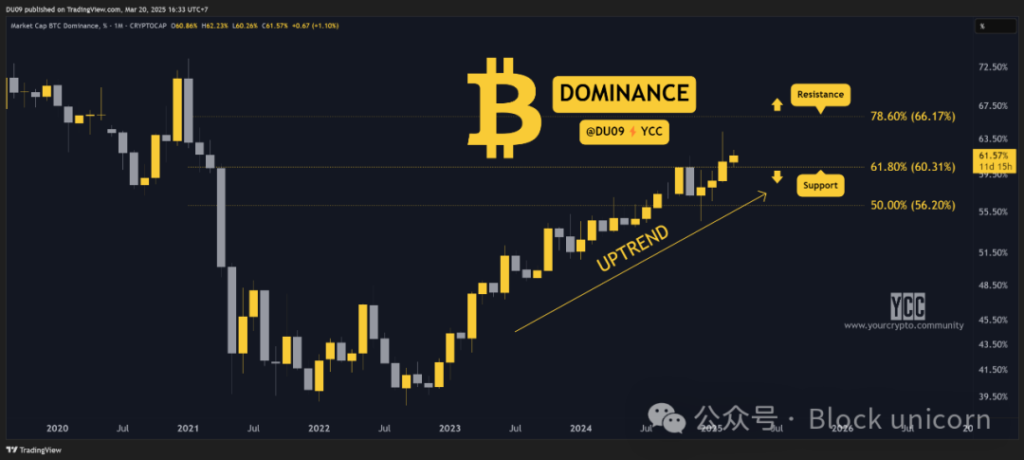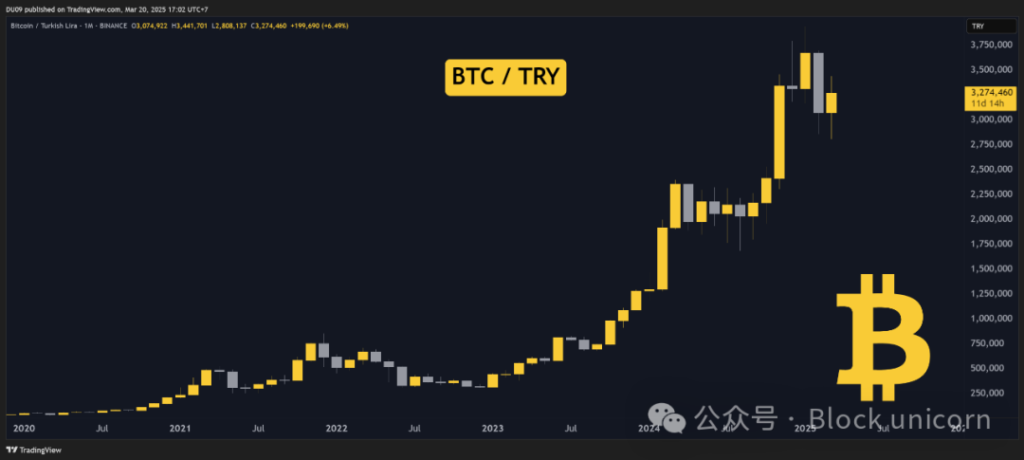Is the Bitcoin four-year cycle dead? In this article, I will answer this question, explain why the past two years have changed everything, and then offer a very important suggestion. Let's begin.
What is the Four-Year Cycle?
This four-year cycle originates from Bitcoin's fundamental principles. Every four years, Bitcoin's inflation rate is halved. As early as 2012, the first halving event reduced new Bitcoin issuance by 50%, from 50 BTC per block to 25 BTC.
This had a massive impact on Bitcoin's supply and demand balance, especially during the first two halving events in 2012 and 2016. At that time, as supply couldn't keep up with demand, Bitcoin's price soared. Other cryptocurrencies (Altcoins) also rose accordingly.
However, the price impact of each new halving event has been weakening. The most recent 2024 Bitcoin halving only reduced new Bitcoin issuance from 6.25 BTC to 3.12 BTC.

Considering that almost 95% of Bitcoin is already in circulation (nearly 20 million out of 21 million BTC), the impact of future halving events on price is rapidly becoming insignificant.
Methods that were effective a few years ago are no longer applicable today. You can't "print free money" by buying any cryptocurrency like before. Now, we have new factors that have a more fundamental impact on the crypto cycle than Bitcoin's halving plan.
It's time to upgrade your thinking! Details will be explained next.
Why Have the Past Two Years Changed Everything?
Two things have changed the cryptocurrency landscape in the past two years:
- Cryptocurrency ETF (Exchange Traded Fund) launch
- Altcoin inflation
In early 2024, Bitcoin was first approved for an ETF. This suddenly opened the global market for Bitcoin. Now, anyone can add Bitcoin to their retirement investment portfolio, which was impossible before.
This represents a massive influx of new funds into Bitcoin that didn't exist before. But there's a problem here.
As funds flow into the Bitcoin ETF, this creates buying pressure on Bitcoin's spot price. However, this liquidity never truly left the Bitcoin ETF to flow into Altcoins, because except for Ethereum, no Altcoin has an ETF. And Ethereum's ETF demand has been disappointing so far, totaling only $2.5 billion.
As of early 2025, almost all ETF liquidity has flowed into Bitcoin, totaling $40 billion, as shown in the chart. No wonder Ethereum has been declining against Bitcoin for years. Most Altcoins are the same.

This is why everyone has been waiting for the "real" Altcoin season in the past two years, and this season may actually never come. The Altcoin rebound in November 2024 appeared pale and weak compared to previous cycles.
Although SOL, XRP, BNB, and TRX hit new historical highs, these prices are not far from previous peaks, and most Altcoins, like Ethereum or ADA, failed to reach new historical highs. This clearly shows that Altcoins are lagging behind Bitcoin.
What is the Reason? Dilution of Altcoins
Compared to previous cycles, the number of Altcoins today is simply too many (millions). I explored this issue in detail in a previous article. In short, the Altcoin season was hijacked by Solana and its Meme coins. This basically drained all Altcoin liquidity.
Shortly after, when Solana's music was loudest, Trump entered the stage in January 2025, breaking up the party. This also ended the Meme coin season, with most Meme coins dropping 80% to 90% since then.
Funds or liquidity in cryptocurrencies are limited and now divided among millions of Altcoins. Moreover, Bitcoin is taking an increasingly larger share. Just look at BTC's market dominance, which is the highest since 2021, over 60%!

Altcoins are in a difficult position. They only occupy 40% of the market, and with millions of coins, there's little liquidity left for the Altcoin season. If you plan to play the Altcoin game, you really need to be careful in your selection.
This reminds me of an interesting analogy in tennis, where players participate in two types of games:
- Those playing a loser's game (Altcoins)
- Those playing a winner's game (Bitcoin)

In the first scenario, tennis players must minimize errors, because by doing so, they can defeat most opponents who make more mistakes. This is a loser's game because winning means losing less than most others.
In the second scenario, tennis players are the cream of the crop. Their matches are no longer about reducing errors, but about technique and becoming a winner. This is a winner's game played by winners (top players).
In cryptocurrency, if you play the Altcoin game, you're playing a loser's game, and to win, you need to pick Altcoins that lose less than others. However, you can completely ignore this and choose to play a winner's game by buying Bitcoin!
It's time to look at Bitcoin and why it will continue to win, regardless of the four-year cycle theory, which has become irrelevant based on the past two years.
Why Bitcoin Remains the King?
I promised you advice at the beginning of the article.
The goal is to play a winner's game, focusing on Bitcoin. This is your way to win in the long term. Limit your exposure to the loser's game (Altcoins) to a controllable range. Otherwise, things could quickly turn bad.
With this premise, here are 10 reasons why betting on Bitcoin makes you a winner:
Fiat Currency (USD) Dilution – Central banks cannot stop printing fiat currency. Look at gold, constantly hitting new highs. Bitcoin is doing the same in 2024, and the $100,000 resistance will eventually be broken. Be patient.
Inflation – It's easy to print USD out of thin air, but you can't print Bitcoin out of nowhere. This makes Bitcoin the hardest currency on Earth. That's where you store your wealth.
Quantitative Tightening is Ending – This means quantitative easing is coming, which will make fiat currency dilution and inflation inevitable.
Global Money Supply Hits Historic Highs – It's not just the US diluting its citizens' wealth; every country is doing so, just at different speeds. Look at Bitcoin's price in Turkish Lira.

Gold – Its record-breaking price trend since late 2023 seems endless. What's better than gold? Bitcoin. Why does everyone buy gold? Because of points 1 to 4. People accepting Bitcoin is just a matter of time.
Crypto ETFs – Calling them crypto ETFs is somewhat misleading because 95% of funds flow into Bitcoin ETFs. This ratio is even more BTC-biased than Bitcoin's 60% market dominance.
Altcoin Dilution – You can't dilute Bitcoin. You can't copy-paste it because you can't replicate its billions of dollars in security and mining equipment.
Nations Buying Bitcoin – Look at El Salvador. More and more countries are adding Bitcoin to their sovereign wealth funds.
US Crypto Strategic Reserve – This basically means what it says. No further explanation needed.
You Have No Better Option – Today, the only reliable currencies are Bitcoin and gold, with the former having a clear advantage.
While Bitcoin's four-year cycle will continue, its impact on price is at best negligible. In this sense, this theory no longer exists. However, the reasons to continue buying Bitcoin are more powerful than ever.
I can't say the same about Altcoins.
This game is becoming increasingly difficult, and over time, picking winners becomes a loser's game. This is completely opposite to betting on Bitcoin, more like betting on the Turkish Lira to protect your wealth. We also know how that ends.







